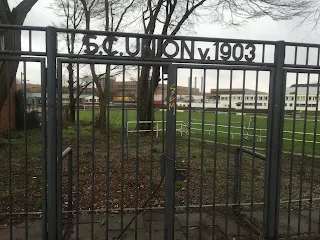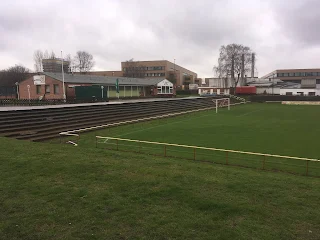Sport-Club
Union von 1903 Altona e.V. is a sports club that was formed by a group of young
apprentices and students in the city of Altona, northern Germany, on June 7th 1903, as FC Union von 1903 Altona; going on to join the Hamburg-Altona Fußball-Bund
in 1905.
The team was installed in the A-Klasse, one of the highest regional levels in the country. Some members split away in 1923 to form neighbouring club SV West-Eimsbüttel, while two years later, the handball department of the club was formed. A tennis section would later follow.
The club changed
their title to Sportclub Union 03 Altona in 1932 and then to SC Union 03
Hamburg in 1937 when Altona was engulfed by the city of Hamburg to become one
of its districts.
The team qualified to play in the Norddeutsche Fußballmeisterschaft, Northern German Football Championship, on nine separate occasions, before the Second World War saw a hundred of the 2,000 club members perish on foreign soil.
Union played
briefly in the top level between 1945 and 1947, but then failed to qualify for
the newly formed Oberliga Nord, so continued in Landesliga Hamburg-Hansa, where
they became champions without winning promotion in 1965-66.
After that, it would be the club’s handball side who gained prominence, going on to become national champions on a couple of occasions. The football side went into steady decline as time elapsed. Membership had dropped to 400 by the turn of the millennium.
Talks took place to form a
merger with Altona FC 1893, which failed to materialise. By the 2002-03
campaign, Union found themselves in the seventh-tier Bezirksliga West, finishing
second from bottom. The team turned that finish around with a runners-up spot in 2003-04, which was repeated the following season.
Remarkably, Union finished bottom of the table in 2006-07 and 2007-08, which was improved by one place the season after. In another astonishing turnaround, the club from Rudolf-Barth-Stadion finished in second place in 2009-10 before narrowly avoiding relegation twelve months later. However, there was to be no escape in 2011-12 with Union finishing bottom of the pile.
Worse was to
follow as the club was relegated two levels to the ninth-level Kreisklasse Staffel
6, where they finished in second place in 2012-13 to win promotion, which was
backed up by a mid-table finish in Kreisliga Staffel 2 for the following couple
of campaigns.
Union
escaped relegation by one position in 2015-16, before having an escape at the
end of the 2016-17 season. Despite finishing in the drop zone, the club was
reprieved and placed in Staffel 7 of the same level, where a runners-up spot
was enough to win promotion.
Back in Bezirksliga
West, Union finished in the relegation zone once again at the end of the
2018-19 campaign. In the Kreisliga, Union found themselves up against the second side of former tenants Falke as they ended in eleventh spot when the Coronavirus outbreak halted the season.
The club was switched from Gruppe 2 to 10 for the 2021-22 season, which saw an improved seventh-place performance under trainer Helge Bormann. A move to Gruppe followed a year later, with Union again on the move in 2024-25, where the Gruppe 8 title was won with Andelko Ivanko in charge of the team, who returned to Bezirksliga Hamburg Nord.
SC Union 03
Altona will play in Bezirksliga Hamburg Nord in the 2025-26 season.
My visit
Thursday 14th March 2019
I had
arrived in the Hamburg rain for a three-day visit of culture, socialising,
sightseeing and football and wanted to visit a few local clubs before checking
in to my hotel.
I’d already
called at the homes of SC Sperber Hamburg and Hamburg-Eimsbütteler BC. I’d
considered leaving the Rudolf-Barth-Stadion until Friday or Saturday morning,
but I was in the mood and already damp, so I bit the bullet.
The fifteen-minute walk took me along normal, wide German streets and alongside the dual
carriageway of Eimsbütteler Marktplatz and then Kieler Straße before doing a
right along Waidmannstraße.
I was
intrigued by co-tenants HFC Falke. They had an attractive-looking website,
but I didn’t delve too deeply into their background. I initially thought that
they were anchor tenants at the venue. To read all about them, click here.
The gates to
the grounds were open. To the left were tennis courts, a hard court, along with an athletics track, which appeared to cater for football in the centre. However,
the path also took me to my intended location past some ticket booths.
Every so
often, with my hobby, you come across an unrealised gem. This was such an
occasion. It was a fantastic old venue. A sort of old Southern League ground in
the UK, minus a main seated stand.
Open
terracing wrapped virtually around three sides. A few open seats were placed at the rear behind the goal, with a large clubhouse behind it. The far goal was
partly open terrace before giving way to Union’s indoor Sports Hall.
I’m not sure
whether the buildings down the west side were associated with Union, but they
backed onto the terrace. Open grass backed the opposite side. The only HFC
Falke presence I could find was a banner in that area of turf.
The
groundsmen played along and posed for an imaginary photo, having a laugh. It’s
little things like that that start a visit to a city off in the right way. I
was delighted at my find and it being open.
Mission
accomplished, I continued along Waidmannstraße and then Plöner Stieg to catch a
train to Altona from Diebsteich station. Within minutes, I was wandering through
the main thoroughfare of Große Bergstraße in what was once a separate city from
Hamburg.
After a
quick call at Aldi to compare the store to back home and grab some provisions,
I located my accommodation, the decent Hotel Stadt Altona, for a freshen up and
brief siesta. My inkling that it was to be a fun stay was confirmed throughout
the evening.
The St Pauli
Evening Walking Tour was interesting and eye-opening, led by Croatian guide
Sabina. I continued in the area afterwards to socialise and have a fantastic
opening night. It certainly set me up for the rest of my stay!












